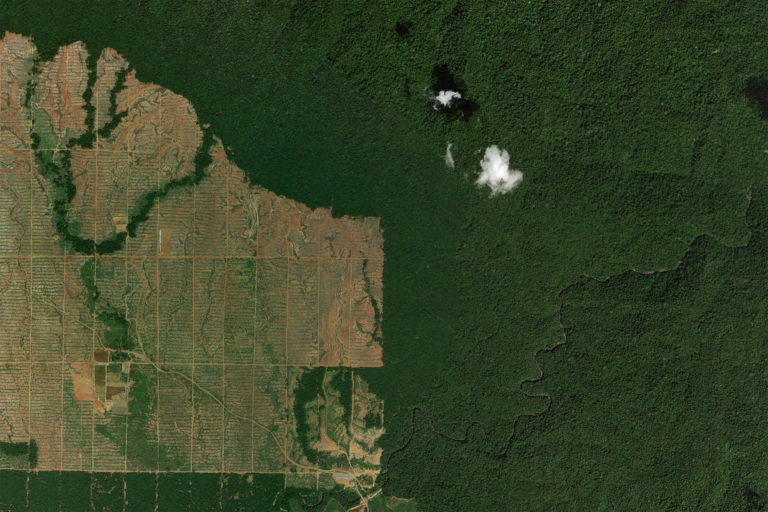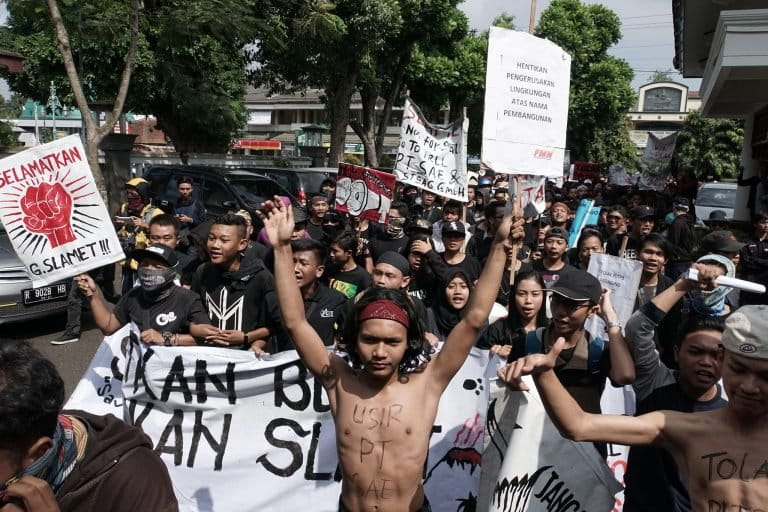- 2021 marked an inflection point for the fate of Indonesia’s rainforests, the largest expanse outside the Amazon and the Congo Basin.
- The year started out with news of a record drop in the deforestation rate in 2020, which the government attributed to its policies but which some observers say was due more to outside factors such as the pandemic.
- This was also the year that a moratorium on issuing licenses for new oil palm plantations came to an end, with experts warning of an impending wave of forest clearing now that the policy has expired.
- Land conflicts pitting local and Indigenous communities against agribusiness companies and developers saw an increase despite the pandemic-driven economic slowdown, with observers pointing to a lack of effective conflict-resolution mechanisms.
Home to more rainforest than any country but Brazil and the Democratic Republic of Congo, Indonesia is one of the world’s most significant nations from an environmental and biodiversity perspective. Here are three of the key forestry stories and trends from Indonesia this year, ranging from a national deforestation slowdown and the end of a freeze on new permits for oil palm plantations to the persistence of conflict over land across the archipelagic country.
Deforestation dropped nationally in 2020, but threats remain
Deforestation has long been a massive problem in Indonesia. Since 2001, Southeast Asia’s largest economy has lost nearly 30 million hectares (74 million acres) of tree cover — an area the size of Italy and second only to Brazil’s forest loss. Indonesia’s annual deforestation rate rose steadily throughout the 2000s, peaking in 2016 before dropping significantly in 2017-2019, a few years after Joko Widodo became president.
Remarkably, 2020 saw another sharp drop in Indonesia’s deforestation rate. Deforestation fell 75% from 2019, according to government data.
There is some dispute as to why this occurred. Widodo’s administration has been quick to take credit for the deforestation slowdown, attributing it to sound government policies. These include a permanent ban on the issuance of permits to clear old-growth forests, a temporary freeze on the issuance of permits for new oil palm plantations, a “social forestry” program meant to empower local communities, a law enforcement campaign aimed at companies and farmers accused of causing forest fires, and a peatland rehabilitation program meant to prevent fires from happening in the first place.
Skeptics have questioned the efficacy of some of Jakarta’s policies, pointing to other factors they say played a perhaps more important role, such as a wetter-than-normal 2020 keeping fires to a minimum, lower palm oil prices (which correlate with lower rates of plantation expansion), and the economic slump brought on by the COVID-19 pandemic. Some observers have argued that the deforestation slowdown is likely to be a temporary blip unless more drastic actions are taken.
Meanwhile, many of Indonesia’s most prominent environmental groups contend that deforestation in the country is actually on the rise. While forest loss declined in the second half of the 2010s compared to the first, from 3.4 million hectares to 2.8 million hectares (8.4 million acres to 6.9 million acres), that’s only true when viewed from a national perspective. A closer look, they say, reveals a worrying trend: that in 10 of Indonesia’s most forest-rich provinces, deforestation actually increased during the same period, from 1.8 million hectares (4.4 million acres) in 2010-2014 to 1.85 million hectares (4.6 million acres) in 2015-2019.

These 10 provinces — West Kalimantan, Central Kalimantan, East Kalimantan, North Kalimantan, Central Sulawesi, Maluku, North Maluku, Papua, West Papua, and Aceh — hold 80% of Indonesia’s remaining forest cover. Several of them lie in the country’s eastern region, which is seen as the final frontier for expansion-minded agribusiness and extractive companies that have already largely depleted the lowland forests of Sumatra and Borneo. This is particularly true in the Papuan provinces, where more than 1 million hectares (2.5 million acres) of forestland have been licensed out to oil palm plantation companies but have yet to be cleared.
“If we could project what will happen to Papua in the next two decades, just look at what’s happening in Sumatra and Kalimantan [Indonesian Borneo] now,” said Mufthi Fathul Barri, a researcher with Forest Watch Indonesia. “Similar things are starting in Papua now and this is a warning for us all.”
Despite 2020’s deforestation slowdown, threats to the nation’s forests remain. Across the country, more than 3.5 million hectares (8.6 million acres) of rainforest still stand on lands licensed over to oil palm companies, according to Madani, an environmental NGO, putting them at risk of being legally cleared. Indonesia’s palm oil-based biofuel program will require 15 million hectares (37 million acres) of new oil palm plantations to meet production targets, officials have said, potentially threatening even more of the archipelago’s forests. And Jakarta’s plan to establish millions of hectares of new farmland across the country under a new “food estate” program has already resulted in the clearance of orangutan habitat in Borneo to make way for a giant cassava plantation, despite assurances from the minister of forestry that this would not happen.
“Don’t let us become like Brazil,” Arief Wijaya, senior manager of climate and forests at the Jakarta office of the World Resources Institute, a Washington, D.C.-based think tank, said earlier this year, referring to the sharp rise in Amazon deforestation under the leadership of President Jair Bolsonaro after a decade in which Brazil’s annual forest loss declined by roughly 80%. “What Indonesia has achieved has to be maintained because the potential for massive deforestation is still there.”

End of the freeze on new oil palm plantation permits
Observers warn of another threat to Indonesia’s forests: the end of a three-year moratorium on the issuance of permits for new oil palm plantations, which was allowed to expire in September.
President Widodo announced the policy in 2015, as Indonesia suffered through yet another bout of disastrous wildfires. The chief underlying cause of the fires, which burn across the archipelago nearly every year, is the wholesale transformation of the nation’s vast peat swamp zones into desiccated landscapes dominated by agribusiness. With land in the archipelago growing ever scarcer, palm oil and paper companies looking to set up new plantations have increasingly turned to Indonesia’s relatively inhospitable peatlands, requiring them to dig countless miles of drainage canals in order to regulate the water levels and establish the right conditions for planting. Doing so dries out the landscape, leaving it highly susceptible to burning.
The moratorium policy, finally signed by Widodo in 2018, was more than just a licensing freeze. It also mandated a review of all existing oil palm plantation permits, with the implication being that problematic ones could be revoked. A similar initiative in the mining sector, initiated by Widodo’s predecessor, had resulted in the cancellation of hundreds of mining licenses. Environmentalists and Indigenous rights advocates welcomed the move, noting that many permits authorizing the exploitation of Indonesia’s vast natural wealth had been issued under legally questionable circumstances.
Despite calls from civil society and some regional government officials to extend the moratorium, Jakarta allowed it to expire in September, with the deputy agriculture minister saying the country would use “existing laws” to regulate the palm oil sector. While the forestry ministry has said it will not rezone any more forestland for oil palm development, it is only a verbal commitment. Some regional administrations, such as Sanggau and Gorontalo on the islands of Borneo and Sulawesi, respectively, have cemented the terms of the moratorium in their bylaws, and others have made their own sustainability pledges, but they remain few and far between.

During the three-year moratorium period, Indonesia made little progress on the permit review. Benidiktus Hery Wijayanto, the head of West Papua’s provincial agriculture office, told Mongabay that when he attended an online meeting in July with officials from four other palm oil-producing provinces, his was the only one that had “gone through the process to make sure their licenses were in order and to see which ones have to be revoked,” as opposed to merely cataloging the number of concessions in their provinces. The consensus among the officials, he said, was that the moratorium should be extended to give regional administrations more time to obtain data from companies, which were often not forthcoming with information.
Unlike the mining sector initiative, the palm oil moratorium saw only a very tiny number of permit revocations. Johny Kamuru, the elected head of Sorong district in West Papua, was among the few regional leaders to have done so, canceling the licenses of several plantation firms on the grounds that a province-wide audit had identified a litany of violations by license holders. Judges struck down a lawsuit filed by two of the companies against Kamuru’s administration in December.
Indonesia’s epidemic of land conflicts continues
Indonesia’s epidemic of land-use conflicts continued unabated, with new data shining light on the extent of the phenomenon.
A research report examining 150 palm oil-related land conflicts in four provinces found that 243 people had been injured and 19 died; at least 30 demonstrations or blockades had been met with violence by the security forces; and 42% of the cases had seen the arrest of community members, with 798 total arrests. The researchers concluded that Indonesia has no effective mechanism for resolving land conflicts. In response to the report, Indonesia’s deputy land minister said his ministry was testing the use of independent mediation agencies to solve two cases, and if they succeeded it could perhaps lead to the establishment of a special body to address conflicts.
The Consortium for Agrarian Reform, an Indonesian nonprofit known as the KPA, said it was surprised to find that land conflicts had increased in 2020, even as the pandemic threw Indonesia into its first recession in decades, which presumably would have limited the activities of natural resource firms. The group recorded 241 land conflicts involving 359 villages in 2020. KPA secretary-general Dewi Kartika said companies had taken advantage of social-distancing measures imposed by the government, which restricted movement and prohibited gatherings such as protests that form a key component of rural land rights advocacy.

While the plantation sector accounted for nearly 70% of the conflicts documented by the KPA, infrastructure projects were another culprit, accounting for 30 cases. Seventeen of these were projects the government has promoted as being of “strategic national importance,” including airports, toll roads, dams and ports, all of which are being built as part of President Widodo’s infrastructure program, a pillar of his presidency. The KPA said it had recorded 2,291 conflicts during Widodo’s first full five years in office, from 2015-2020, compared to 1,770 cases under the previous administration, which ran from 2004-2014.
The mining sector also saw its share of conflict between large corporations and local communities. JATAM, a mining industry watchdog, said 69 people were “criminalized” in disputes with mining firms in 2020.
Jakarta’s “10 New Bali’s” program to establish new tourism sites across the country has fueled conflict in at least one community, with members of the Indigenous Pomparan Ompu Ondol Butarbutar saying they face eviction from their lands as a result of a luxury hotel project.
Meanwhile, a long-running campaign by Indigenous peoples to obtain formal recognition of their customary lands remains far short of its goals. As of July, the central government had granted customary land titles to 80 communities, covering a total of 59,442 hectares (146,884 acres), far short of the 10.6 million hectares (26.2 million acres) of ancestral forests that have been mapped by 833 Indigenous groups. A bill on Indigenous rights that would establish clearer rules around their land tenure continues to languish in the nation’s parliament.
Despite a ruling by Indonesia’s Supreme Court ordering it to release the data, the land ministry continues to withhold oil palm plantation permit data from public view, which environmental groups say is impeding the resolution of land conflicts.
Banner image: Deforestation for oil palm. Image courtesy of Greenpeace.
Additional reporting by Hans Nicholas Jong.

